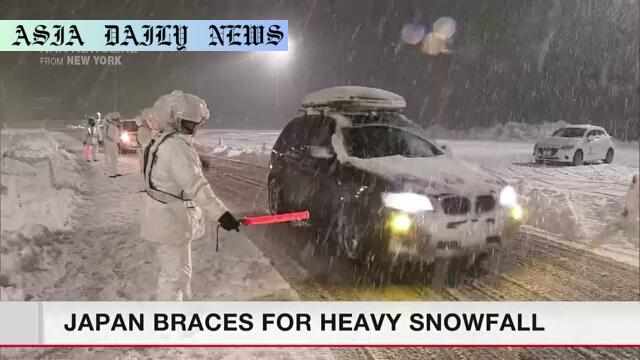Snowfall disrupts Hokkaido, Tokachi region suffers highest-ever 12-hour accumulation with alarming 129cm snowfall.
Record snowfall of 129cm reported in Tokachi, Hokkaido.
Caused by moist air and a rapidly developing low-pressure system.
Major disruptions forecasted in Hokuriku, Niigata, and beyond.
Snow accumulation expected to intensify in multiple Japanese regions.

Snowfall Reaches Record Levels in Tokachi, Hokkaido
Introduction
The Tokachi region of Hokkaido, northern Japan, has experienced unprecedented snowfall, setting new records for 12-hour accumulation. From late Monday to Tuesday morning, snow blanketed the region at an incredible rate, creating challenges for residents and government agencies alike. This event serves as an alarming reminder of the intensity that nature can bring, further exacerbated by unique atmospheric conditions.
Record-Breaking Snowfall Reported
Weather officials have confirmed that Obihiro City in the Tokachi region recorded a staggering 129 centimeters of snow within just 12 hours. This is the highest snowfall ever measured nationwide within such a short duration. The phenomenon was caused by a combination of a rapidly developing low-pressure system and moist air moving across the region. These factors created persistent snow clouds, which heavily impacted the Tokachi area.
Impact on Neighboring Regions
Other areas in northern Japan, such as the Kushiro-Nemuro region, also observed record-breaking snowfall during this period. The Meteorological Agency has reported similar snowfall patterns in areas along the Sea of Japan. Areas like the Hokuriku region, Niigata Prefecture, and other parts of western Japan have been alerted to brace for increasing snow levels.
Critical Weather Forecast
The 24-hour forecast through Wednesday evening predicts up to 100 centimeters of additional snowfall in the Hokuriku region and Niigata Prefecture. Other areas such as Tohoku could see 80 centimeters, and regions like Kinki and Gifu are anticipating 70 centimeters. Even regions further south, including Kyushu and Shikoku, may experience up to 40 centimeters of snowfall, a highly unusual occurrence in these warmer areas.
Transportation and Infrastructure Disruptions
The heavy snowfall has already caused significant transportation disruptions in affected regions. Snow and ice have complicated road conditions, while rail systems and flights face delays or cancellations. Authorities are urging residents to avoid unnecessary travel and prepare for extended periods of slow or halted infrastructure services.
Safety Warnings and Precautions
Authorities have emphasized safety precautions, including avoiding outdoor activities during peak snowfall and ensuring preparedness for emergencies. Snowfall can cause building collapses, road blockages, and power outages. People in the impacted regions are advised to stock up on essentials, charge electronic devices, and remain vigilant to warnings issued by local authorities.
Broader Implications of Extreme Weather
This extreme weather highlights the unpredictable nature of atmospheric patterns influenced by multiple factors, including global climate shifts. While heavy snowfall is not uncommon in Japan, the intensity and scale of this event have raised concerns about resource management, disaster preparedness, and climate resilience for local and national governments. Continued meteorological monitoring and analysis are essential for understanding the long-term impacts and patterns of these weather phenomena.
Conclusion
The Tokachi region’s record-breaking snowfall underscores the importance of staying alert during extreme weather conditions. Residents, authorities, and businesses alike must prioritize safety, resource management, and disaster preparedness as more intense weather events become likely in the future. By learning from this event, Japan can push forward measures to mitigate risks and enhance resilience against sudden climatic changes.
Commentary
Unpredictable Weather Patterns
Snowfall in Japan is a common occurrence during winter, especially in northern regions like Hokkaido. However, the sheer intensity of this recent storm is remarkable and perhaps even unsettling. Record-breaking snowfall of 129 centimeters in just 12 hours is an event that disrupts the normalcy of daily life and serves as a stark reminder of nature’s unpredictable force. Situations like this make it clear that no amount of preparedness is absolute in the face of extreme weather.
Impact on Communities and Infrastructure
Events such as these introduce significant challenges for vulnerable communities in affected regions. The disruptions to transportation networks, essential services, and the overall safety of roads highlight the fragility of even well-prepared areas. As snow accumulates in various regions across Japan, it is essential for local authorities to respond swiftly and effectively to minimize risks to both life and property.
A Need for Climate Resilience
While this specific incident may not be directly attributable to long-term climate change, the increasing intensity and unexpected nature of weather events worldwide paint a concerning picture. It is imperative for authorities, not just in Japan but globally, to re-evaluate strategies for disaster preparedness and climate resilience. Through advanced forecasting technologies and community engagement, future impacts of such extreme weather can be mitigated.
Final Thoughts
We can only hope for the safety of those affected in Hokkaido and beyond while appreciating the power and unpredictability of nature. Times like these remind us of the importance of cooperation, preparedness, and thoughtful policy to ensure humanity’s resilience in an ever-changing world. Let this serve as both a call to action and a moment to reflect on the challenges we face in adapting to our environment.


